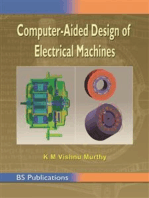Numerical Relay
Numerical Relay
Uploaded by
c_chootiaCopyright:
Available Formats
Numerical Relay
Numerical Relay
Uploaded by
c_chootiaCopyright
Available Formats
Share this document
Did you find this document useful?
Is this content inappropriate?
Copyright:
Available Formats
Numerical Relay
Numerical Relay
Uploaded by
c_chootiaCopyright:
Available Formats
INTRODUCTION to RELAYS Relays are devices by means of which an electric circuit can be controlled (opened/closed) by the change in the
same circuit or the other circuit. The protective systems are necessary with almost every electric plant. The power systems comprise many diverse items of equipment which are very expensive, so the complete power system represents a very large capital investment. No matter how well designed, faults will occur on a power system and these faults may represent a risk of life and property. The provision of adequate protection to detect and disconnect the elements of power system in the event of fault is therefore an integral part of power system design. In order to fulfill the requirements of protection with optimum speed for the many different configurations, operating conditions and construction feature of the power system, it has been necessary to develop many types of relays that respond to various functions if the power system quantities.
Relays may be classified according to the technology used _ Electromechanical _ Static _ Numerical ELECTRO-MECHANICAL RELAYS Electromechanical relays are the conventional relays having movable sub-assemblies. The operation of such relays depending upon the electromagnetic attraction or electromagnetic induction effects of electric current. The protection system if the plant is implemented by using electro mechanical relays, except a fewer number of static relays. Electro mechanical relays can be classified to several different types: _ Attracting armature type _ Polarised attracted armature relay _ Moving coil _ Induction type _ Thermal _ Motor operated _ Mechanical
STATIC RELAYS A static relay referred to the relay, which has no armature or other moving elements. The measurement is carried out by stationary electronics circuits. The solid state components used are transistors, resistors, capacitors and so on. The response is developed by electronic, magnetic, optical or other components without mechanical motion. Static relays have quick response, long life, shock-proof, fewer problems of maintenance, high reliability and high degree of accuracy.
INTRODUCTION TO NUMERICAL RELAY Conventional electromechanical and static relays are hard wired relays. Their wiring is fixed, only their setting can be manually changed. Numeric relays are programmable relays. The characteristics and behavior of the relay are can be programmed. They have numerous advantages. They have small burden on CTs and PTs. They can process and display the signals efficiently, accurately and fast as possible manner. The electromechanical relay devices occupy large amount of space in the panel board. Although accuracy is maintained at a better level it can be improved by the use of numerical relays. Traditional electromechanical and static protection relays offers single-function and single characteristics. Range of operation of electromechanical relays is narrow as compared to numerical relay. Electromechanical Relay makes use of mechanical comparison devices, which cause the main reason for the bulky size of relays. It uses a flag system for the indication purpose whether the relay has been activated or not. Electromechanical relay do not have the ability to detect whether the normal condition has been attained once it is activated thus auto resetting is not possible and it has to be done by the operating personnel.
WHY SWITCH TO NUMERICAL RELAY? Numerical relays are highly compact devices, characterized with fast operation, high sensitivity, self-monitoring and low maintenance. First generation numerical relays were mainly designed to meet the static relay protection characteristic, whereas modern numeric protection devices are capable of providing complete protection with added functions like control and monitoring. Numerical protection devices offer several advantages in terms of protection, reliability, and trouble shooting and fault information. Numerical protection devices are available for generation, transmission and distribution systems. Modern power system protection devices are built with integrated functions. Multi-functions like protection, control, monitoring and measuring are available today in numeric power system protection devices. Also, the communication capability of these devices facilitates remote control, monitoring and data transfer. Modern numeric protection offers multi-function and multiple characteristics. Some protections also offer adaptable characteristics, which dynamically change the protection characteristic under different system conditions by monitoring the input parameters. The measuring principles and techniques of conventional relays (electromechanical and static) are fewer than those of the numerical technique, which can differ in many aspects like the type of protection algorithm used, sampling, signal processing, hardware selection, software discipline, etc. These are microprocessor-based relays in contrast to other relays that are electromechanically controlled. These relays provide great precision and convenience in application in the sophisticated electronic products. By combining several functions in one case, numerical relays also save capital cost and maintenance cost over electromechanical relays. The disadvantages of a conventional electromechanical relay are overcome by using microcontroller for realizing the operation of the relays. Microcontroller based relays perform very well and their cost is relatively low
HISTORY OF NUMERICAL RELAY. The first protection devices based on microprocessors were employed in 1985. The widespread acceptance of numerical technology by the customer and the experiences of the user helped in developing the second generation numerical relays in 1990. First generation numerical relays were mainly designed to meet the static relay protection characteristic, whereas modern numeric protection devices are capable of providing complete protection with added functions like control and monitoring. Numerical protection devices offer several advantages in terms of protection, reliability, and trouble shooting and fault information. Numerical protection devices are available for generation, transmission and distribution systems. Modern power system protection devices are built with integrated functions. Multi-functions like protection, control, monitoring and measuring are available today in numeric power system protection devices.
Also, the communication capability of these devices facilitates remote control, monitoring and data transfer. Traditionally, electromechanical and static protection relays offered singlefunction, single characteristics, whereas modern numeric protection offers multi-function and multiple characteristics. Some protections also offer adaptable characteristics, which dynamically change the protection characteristic under different system conditions by monitoring the input parameters. The measuring principles and techniques of conventional relays (electromechanical and static) are fewer than those of the numerical technique, which can differ in many aspects like the type of protection algorithm used, sampling, signal processing, hardware selection, software discipline, etc.
PIC MICROCONTROLLER PIC is a family of Harvard architecture microcontrollers made by Microchip Technology. The name PIC initially referred to Programmable Interface Controller. PICs are popular with both industrial developers due to their low cost, wide availability, large user base, extensive collection of application notes, availability of low cost or free development tools, and serial programming (and re-programming with flash memory) capability. The PIC architecture is distinctively minimalist. It is characterized by the following features: Separate code and data spaces (Harvard architecture) A small number of fixed length instructions Most instructions are single cycle execution (4 clock cycles). A single accumulator (W), the use of which (as source operand) is implied (i.e. is not encoded in the opcode) All RAM locations function as registers as both source and/or destination of math and other functions. A hardware stack for storing return addresses. Data space mapped CPU, port, and peripheral registers. The program counter is also mapped into the data space and writable (this is used to implement indirect jumps). Unlike most other CPUs, there is no distinction between memory space and register space because the RAM serves the job of both memory and registers, and the RAM is usually just referred to as the register file or simply as the registers.
Data space (RAM) PICs have a set of registers that function as general purpose RAM. Special purpose control registers for on-chip hardware resources are also mapped into the data space. The addressability of memory varies depending on device series, and all PIC devices have some banking mechanism to extend the addressing to additional memory. Code space All PICs feature Harvard architecture, so the code space and the data space are separate. PIC code space is generally implemented as EPROM, ROM, or flash ROM. In general, external code memory is not directly addressable due to the lack of an external memory interface. Word size All PICs handle data in 8-bits, so they should be called 8-bit microcontrollers. However, the unit of addressability of the code space is not generally the same as the data space.
Stacks PICs have a hardware call stack, which is used to save return addresses. The hardware stack is not software accessible on earlier devices, but this changed with the 18 series devices. Instruction set PICs instructions vary from about 35 instructions for the low-end PICs to over 80 instructions for the high-end PICs. The instruction set includes instructions to perform a variety of operations on registers directly, the accumulator and a literal constant or the accumulator and a register, as well as for conditional execution, and program branching. Some operations, such as bit setting and testing, can be performed on any numbered register, but bi-operand arithmetic operations always involve W; writing the result back to either W or the other operand register. To load a constant, it is necessary to load it into W before it can be moved into another register. Limitations The PIC architectures have several limitations: Only a single accumulator A small instruction set Memory must be directly referenced in arithmetic and logic operations, although indirect addressing is available via 2 additional registers
PIC 16F72 MICROCONTROLLER PIC16F62 is a 28-pin, 8-bit CMOS Flash drive with A/D converter. Features of PIC16F72 are: Only 35 single word instructions to learn All single cycle instructions except for program_branches, which are two-cycle Operating speed! DC 20 MHz clock input DC 200 ns instruction cycle 2K x 14 words of Program Memory,_128 x 8 bytes of Data Memory (RAM) Interrupt capability Eight-level deep hardware stack Direct, Indirect and Relative Addressing modes
Peripheral Features 1. High sink/source current: 25mA 2. Timer0: 8-bit timer 3. Timer1: 16-bit timer 4. Timer2: 8-bit timer 5. 8-bit, 5 channel analog-to-digital converter 6. Synchronous serial port CMOS Technology 1. Low power, high speed CMOS FLASH technology 2. Wide operating range : 2.0V to 5.5V 3. Industrial Temperature Range. 4. Low power consumption. Special Microcontroller Features 1. 1000 erase/write cycle FLASH program memory. 2. Programmable code protection. 3. Power saving sleep mode. 4. Processor read access to program Memory
PIN DIAGRAM
SOFTWARE USED TO PROGRAM THE MICROPROCESSOR PIC16F72 has been programmed using Basic language for the relay operation. The programming has been done in Proton IDE software which is then converted to HEX format using the conversion software PICkit 2 and the HEX converted program is written into the flash memory of PIC16F72. Program has been written based on the following flowchart. Screenshot for Proton IDE
Screenshot for PICkit - 2
HARDWARE Hardware for the Numerical relay simulation circuit mainly consists of two sections: a. Input Simulator b. Numerical Relay with microcontroller Input Simulator For the simulation of relay the fault conditions are generated using an input simulator which generates the normal working conditions of the generating plant such as voltage,
current, frequency, speed of turbine and excitation condition. By varying the values of these quantities fault conditions can be generated for making the relay to act.
Numerical Relay Numerical relay is designed with the help of PIC16F72 microcontroller, which compares various inputs with the set values. When a fault condition is generated using input simulator, the input to microcontroller violates the relay set conditions which cause the controller to send trip signal to relay devices and thus the relay acts.
ADVANTAGES OF NUMERICAL RELAY 1. Multiple functions can be achieved using numerical relay. 2. The size of numerical relay panel is small as compared to electromechanical relay panel. 3. Time and date of fault occurrence can be automatically recorded. 4. Cost can be reduced significantly. 5. Auto resetting can be achieved 6. Better accuracy of operation. 7. Can be reprogrammed as per the working requirement 8. Installation time required is very less as connections required are small. DISADVATAGES OF NUMERICAL RELAY 1. Operating life of numerical relay is only about 20 years. 2. It requires continuous power supply for its operation. 3. Any error in the software may cause severe damage to devices associated with it.
You might also like
- The Technology of Instrument Transformers: Current and Voltage Measurement and Insulation SystemsFrom EverandThe Technology of Instrument Transformers: Current and Voltage Measurement and Insulation SystemsNo ratings yet
- Article 16 Magnetic Flux Leakage (MFL) ExaminationDocument5 pagesArticle 16 Magnetic Flux Leakage (MFL) ExaminationleonciomavarezNo ratings yet
- MMLG 01-02-03 - 04 Manual GBDocument8 pagesMMLG 01-02-03 - 04 Manual GBethan625No ratings yet
- DISCUSSION Load Flow AnalysisDocument4 pagesDISCUSSION Load Flow AnalysisKu WhereNo ratings yet
- Presentation DIP5000 enDocument31 pagesPresentation DIP5000 enNeelakandan MasilamaniNo ratings yet
- PV System Inspection Report: Page 1 of 2 Initial Verificationperiodic VerificationDocument2 pagesPV System Inspection Report: Page 1 of 2 Initial Verificationperiodic Verificationnino causapinNo ratings yet
- PIC16C54 ProgrammerDocument2 pagesPIC16C54 ProgrammerAmel Mulahusic0% (1)
- Epac 3000 Rev2 Hardware Manual Rev 1.0Document33 pagesEpac 3000 Rev2 Hardware Manual Rev 1.0Anonymous ouFzvkzNo ratings yet
- Substation Automation Basics - The Next GenerationDocument8 pagesSubstation Automation Basics - The Next GenerationAlly RaxaNo ratings yet
- PWR Sys Fund Relay ApplicationsDocument231 pagesPWR Sys Fund Relay ApplicationsJohn BihagNo ratings yet
- Relayaux: Auxiliary Relays For Tripping and Control ApplicationsDocument28 pagesRelayaux: Auxiliary Relays For Tripping and Control ApplicationsKuenley TiNy OndeNo ratings yet
- Study of Supervising and Monitoring of Numerical RelaysDocument30 pagesStudy of Supervising and Monitoring of Numerical RelayskhethanNo ratings yet
- Numerical Differential Protection Principles and Applications by Gerhard Ziegler 5 Star Review PDFDocument2 pagesNumerical Differential Protection Principles and Applications by Gerhard Ziegler 5 Star Review PDFSrimannarayana Nandam0% (1)
- EHT Studies - PKpattanaik-2017Document8 pagesEHT Studies - PKpattanaik-2017Guru MishraNo ratings yet
- TestingQuadDistance 5 11 2015 PDFDocument14 pagesTestingQuadDistance 5 11 2015 PDFPandrayar MaruthuNo ratings yet
- Experiment: Setting and Testing of Differential Relay Using ETAP 1.0 ObjectiveDocument2 pagesExperiment: Setting and Testing of Differential Relay Using ETAP 1.0 ObjectivekashifNo ratings yet
- What Is The Best Protective Relay Test-Set - Valence Electrical Training ServicesDocument12 pagesWhat Is The Best Protective Relay Test-Set - Valence Electrical Training ServicesanuragpugaliaNo ratings yet
- T PRO 4000 Manual PDFDocument406 pagesT PRO 4000 Manual PDFAnonymous 3mzzF5C100% (1)
- User ManualDocument108 pagesUser ManualAngelica Escobar MorenoNo ratings yet
- 1mrk509006-Ben en Impedance Relay and Protection Assemblies RXZK 21h-23h RazkDocument20 pages1mrk509006-Ben en Impedance Relay and Protection Assemblies RXZK 21h-23h Razkpb21No ratings yet
- 7sd52 7sd62 ConfigurationDocument14 pages7sd52 7sd62 ConfigurationWilber LucasNo ratings yet
- 7SR23 DAD Complete Technical ManualDocument222 pages7SR23 DAD Complete Technical Manualsvanand88No ratings yet
- CAG14Document8 pagesCAG14aja295No ratings yet
- Current Relays (IT, IS, IA, ID, IP, NT, IM, RT, FI and IV) : Data SheetDocument32 pagesCurrent Relays (IT, IS, IA, ID, IP, NT, IM, RT, FI and IV) : Data SheetJuan PerezNo ratings yet
- Mho Relay 2 PDFDocument8 pagesMho Relay 2 PDFArion BaboolalNo ratings yet
- ABB REL670 V2.2.1 A32 ZMF Line PTT User Manual ENU PDFDocument7 pagesABB REL670 V2.2.1 A32 ZMF Line PTT User Manual ENU PDFWafa Imene BouhaddaNo ratings yet
- Micom Agile P841: Grid SolutionsDocument8 pagesMicom Agile P841: Grid SolutionsTaQuangDucNo ratings yet
- Muhammad Abdul Fareh Khan 2k19Document5 pagesMuhammad Abdul Fareh Khan 2k19Fareh KhanNo ratings yet
- Designing Over Current Relay Logic in MATLABDocument4 pagesDesigning Over Current Relay Logic in MATLABAl Imam AkbarNo ratings yet
- Ret670 Setting ManualDocument1,430 pagesRet670 Setting ManualAndrea MaurillaNo ratings yet
- Basic Relay TestDocument2 pagesBasic Relay TesthendrexNo ratings yet
- Testingcommissioning Blogspot QaDocument6 pagesTestingcommissioning Blogspot QaratheeshkumardNo ratings yet
- T-7 Maintenance ReportDocument18 pagesT-7 Maintenance ReportUsama ZafarNo ratings yet
- CSC 326 Transformer Protection Ied Technical Application Manual v1 02Document329 pagesCSC 326 Transformer Protection Ied Technical Application Manual v1 02rommel76No ratings yet
- Duties of Induction MotorsDocument20 pagesDuties of Induction MotorsIee XpNo ratings yet
- Trivector MeterDocument2 pagesTrivector MeterTarun AhujaNo ratings yet
- 7UT633 SettingsDocument7 pages7UT633 SettingsBalajiNo ratings yet
- SIFANG CSC-101 - V1.20 - Numerical EHV Transmission Line Protection Equipment Manual - 2014-01Document115 pagesSIFANG CSC-101 - V1.20 - Numerical EHV Transmission Line Protection Equipment Manual - 2014-01MarkusKunNo ratings yet
- Case Study 132-11KVDocument7 pagesCase Study 132-11KVarsalanhamid100% (2)
- P438 EN M R-b5-A 311 661 PDFDocument1,192 pagesP438 EN M R-b5-A 311 661 PDFAshutosh KumarNo ratings yet
- Synopsis Proposal For 2021Document4 pagesSynopsis Proposal For 20212k18-EE-243 Vethushan VinnayagamoorththiNo ratings yet
- ASHIDA Numerical OC/EF ASHIDA Numerical OC/EF Protection RelayDocument8 pagesASHIDA Numerical OC/EF ASHIDA Numerical OC/EF Protection RelayVishwanath TodurkarNo ratings yet
- Micom P740Document18 pagesMicom P740vsrikala68No ratings yet
- 5B3Document2 pages5B3h2006078No ratings yet
- KR Monograph July2013Document410 pagesKR Monograph July2013Soumya RoyNo ratings yet
- Template Manual AREVA P441 P442 P444 E33 ENU TU2.20 V1.000Document17 pagesTemplate Manual AREVA P441 P442 P444 E33 ENU TU2.20 V1.000karthikNo ratings yet
- A Summary of Protection RelaysDocument2 pagesA Summary of Protection RelaysarsalanhamidNo ratings yet
- Ag 13 Motor ProtectionDocument3 pagesAg 13 Motor ProtectionRajmohanNo ratings yet
- How To Do The Goose Configuration For Siemens-Siemens OnlyDocument10 pagesHow To Do The Goose Configuration For Siemens-Siemens Onlylinep63715No ratings yet
- UR Relays Percent Differential Element Testing Application NoteDocument13 pagesUR Relays Percent Differential Element Testing Application NotegilbertomjcNo ratings yet
- Easypact Cvs 2011engDocument84 pagesEasypact Cvs 2011engthiago_gomes7953No ratings yet
- 7SR18 Solkor Technical ManualDocument405 pages7SR18 Solkor Technical ManualANTONIO SOLISNo ratings yet
- L1-V4-04-MiCOM C264 HMI-F-03Document35 pagesL1-V4-04-MiCOM C264 HMI-F-03Ahmad SolihinNo ratings yet
- Numerical RelaysDocument18 pagesNumerical RelaysPremlataAroraNo ratings yet
- Flexibility and Reliability of Numerical Protection RelayDocument6 pagesFlexibility and Reliability of Numerical Protection RelayEngr. AbdullahNo ratings yet
- Evolution of Protection Relays From AlstomDocument4 pagesEvolution of Protection Relays From AlstomE.Avinash0% (2)
- Advanced Differential Protection Scheme Using MicrocontrollerDocument3 pagesAdvanced Differential Protection Scheme Using MicrocontrollerkavirajputNo ratings yet
- Digital Protection SchemesDocument12 pagesDigital Protection Schemessanayai143No ratings yet
- Presentation On Numerical RelaysDocument36 pagesPresentation On Numerical RelaysSukant Kumar Mohanty0% (1)
- PCMDocument181 pagesPCMsagsgNo ratings yet
- Ele SyllabusDocument127 pagesEle SyllabusFaiz AnNo ratings yet
- Laptop Repairing NotesDocument70 pagesLaptop Repairing NotesGilberto GomesNo ratings yet
- B.E. EceDocument2 pagesB.E. EceJesintha CharlesNo ratings yet
- 5 A 0105 EE486 DigitalDocument1 page5 A 0105 EE486 DigitalNagarjuna MalladhiNo ratings yet
- 60 GHZDocument9 pages60 GHZjackofmanytradesNo ratings yet
- Symmetrical Components PDFDocument24 pagesSymmetrical Components PDFtanayspatel100% (1)
- 224plc Based Railway Level Crossing Gate Control PDFDocument5 pages224plc Based Railway Level Crossing Gate Control PDFS.m. Salahuddin100% (1)
- Rotor-Earth-Fault Protection: The Year of Profitable GrowthDocument26 pagesRotor-Earth-Fault Protection: The Year of Profitable GrowthJohn SmithNo ratings yet
- Microwave JunctionsDocument20 pagesMicrowave JunctionsSaraswathi Asirvatham100% (2)
- EE 211 CHAPTER 2 Part2Document22 pagesEE 211 CHAPTER 2 Part2RickNo ratings yet
- DiodeDocument8 pagesDiodeTharindu ManamperyNo ratings yet
- RF AmplifierDocument58 pagesRF AmplifierjaoudeNo ratings yet
- Bcr16Pm: Mitsubishi Semiconductor TriacDocument6 pagesBcr16Pm: Mitsubishi Semiconductor TriacalexandreanubisNo ratings yet
- Add A Thermometer To Your Digital Multimeter - Embedded LabDocument13 pagesAdd A Thermometer To Your Digital Multimeter - Embedded LabGourmand OishiiNo ratings yet
- STL128D: High Voltage Fast-Switching NPN Power TransistorDocument12 pagesSTL128D: High Voltage Fast-Switching NPN Power TransistorDiego SerranoNo ratings yet
- Unit 2 Voltage and Current SourcesDocument33 pagesUnit 2 Voltage and Current SourcesVimala ElumalaiNo ratings yet
- Definition of SensorsDocument6 pagesDefinition of SensorsMaela PlacidoNo ratings yet
- Cita Study 2Document125 pagesCita Study 2Luciano Rosado SoccolNo ratings yet
- Ahb To Memory InterfaceDocument5 pagesAhb To Memory InterfaceSuhas ShirolNo ratings yet
- Module3 PDFDocument46 pagesModule3 PDFmacanNo ratings yet
- What Are Breakout Boards SMT Breakout PCBDocument14 pagesWhat Are Breakout Boards SMT Breakout PCBjackNo ratings yet
- Energy Efficient Artificial LightingDocument17 pagesEnergy Efficient Artificial LightingPathum SudasingheNo ratings yet
- CH 08Document29 pagesCH 08miathegirl9No ratings yet
- Manual Solar CellDocument4 pagesManual Solar CellSourabh SainiNo ratings yet
- Wycliffe ProjectDocument50 pagesWycliffe ProjectSmartinz KarurizNo ratings yet
- VI. Geometrical Optics: Physics 425 - Modern Optics Geometrical Optics Lecture Notes - W. Andreas SchroederDocument25 pagesVI. Geometrical Optics: Physics 425 - Modern Optics Geometrical Optics Lecture Notes - W. Andreas SchroedermikeNo ratings yet
























































































